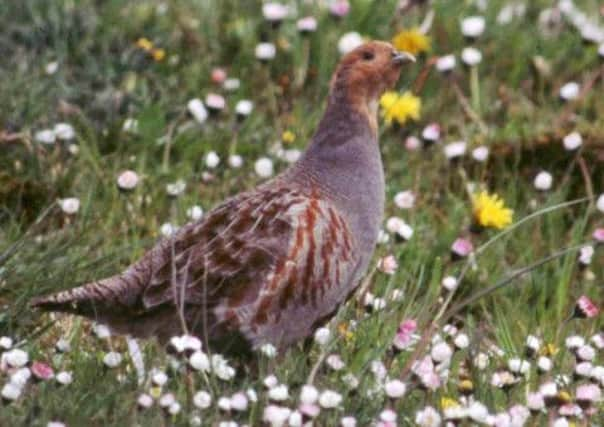Changes to farming have hit gamebirds


It’s the time of year when keen country sportsmen traditionally dusted the heather pollen off their boots and headed for the hill fringe to take a shot at the Scottish grey partridge.
But gone are the days when this plump gamebird appeared in such numbers that a harvestable surplus could be taken for the pot. Instead, here are the days when this iconic bird is struggling to cling to the last pockets of suitable habitat in Scotland’s countryside.
Advertisement
Hide AdAdvertisement
Hide AdThe grey partridge has been described as one of the archetypal farmland birds. Like the skylark and the corn bunting, it is closely associated with open-farmed landscapes and is therefore sensitive to changes in farming intensity. It has undergone a 91 per cent decline in abundance between 1970 and 2009 and a 19 per cent contraction in range between 1970 and 1990.
As a result of these declines, the grey partridge is on the UK red list of Birds of Conservation Concern and was designated as a Biodiversity Action Plan species.
Grey partridge numbers
It is also one of the 19 species that make up the Farmland Bird Index and one of the UK’s official Biodiversity 2020 indicators.
Historically, grey partridge numbers fluctuated according to the economic viability of British agriculture, doing badly during periods of agricultural slump and doing well during the years of arable expansion.
The current sustained decline in grey partridge numbers began in the 1950s as this was the time when the agricultural industry in the UK began the process of intensification, both increasing production per unit area and polarising production so that mixed arable/livestock farms were replaced in the west by all-grass farms and in the east by all-arable farms.
Agricultural policy still has an important influence on grey partridge distribution and abundance as elements of wildlife conservation are introduced to national and European policies in the form of agri-environment schemes – and as the take-up of such schemes is affected by the international price of commodity crops such as cereals.
We know that the three ingredients of habitat, predator control and food source makes for the best environment for grey partridges, but how do we fit their needs into an already over-crowded, small island where the countryside is under huge pressure to produce food?
Knitting-together of production and conservation
Nature conservation must adapt and develop just as agriculture has. New ideas must be explored to encompass biodiversity needs while retaining viable rural businesses.
Advertisement
Hide AdAdvertisement
Hide AdLandscape-scale approaches should be embraced and the bigger picture for Scotland’s wildlife realised before we lament the demise of not just the Scottish greys but a host of other species.
A knitting-together of production and conservation has to occur on a larger scale if we are not to witness the unravelling of our natural heritage.
Our grey partridge demonstration project at Whitburgh Farms in Midlothian is seeking answers to the partridge puzzle.
With all three management ingredients already in the mix, this project aims to, in time, demonstrate to Scottish farmers how we can boost the fortunes of the grey and with it a suite of other farmland species, while maintaining a productive rural landscape.
The declines in farmland wildlife can be reversed and our work on grey partridge elsewhere in the country clearly demonstrates this. Our national Partridge Count Scheme (PCS) – which encourages land managers to monitor greys and implement good practice – has had significant effect.
Core to the approach of the scheme is persuading such people that, even if they have only a few grey partridges on their land, it is worth making the effort to conserve them because every increase contributes to the restoration of the species.
Grey partridge spring densities on PCS properties have increased by 81 per cent between 2000 and 2010, while the national population monitored has declined by 40 per cent over the same period.
• Katrina Candy is media and education officer at the Game and Wildlife Conservation Trust Scotland